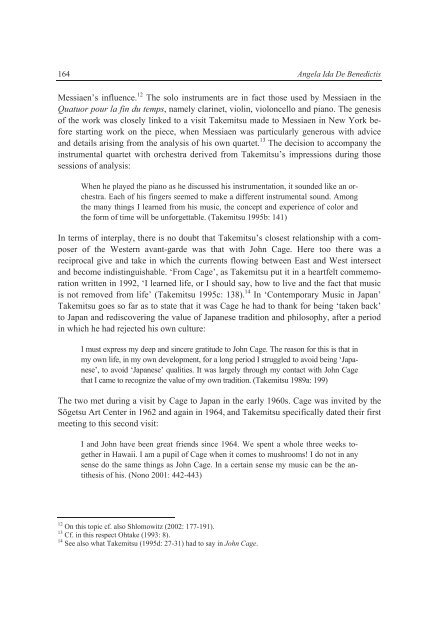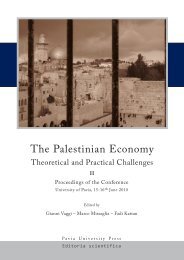Musica che affronta il silenzio - Scritti su Toru Takemitsu - Pavia ...
Musica che affronta il silenzio - Scritti su Toru Takemitsu - Pavia ...
Musica che affronta il silenzio - Scritti su Toru Takemitsu - Pavia ...
You also want an ePaper? Increase the reach of your titles
YUMPU automatically turns print PDFs into web optimized ePapers that Google loves.
164<br />
Angela Ida De Benedictis<br />
Messiaen’s influence. 12 The solo instruments are in fact those used by Messiaen in the<br />
Quatuor pour la fin du temps, namely clarinet, violin, violoncello and piano. The genesis<br />
of the work was closely linked to a visit Takemit<strong>su</strong> made to Messiaen in New York before<br />
starting work on the piece, when Messiaen was particularly generous with advice<br />
and deta<strong>il</strong>s arising from the analysis of his own quartet. 13 The decision to accompany the<br />
instrumental quartet with or<strong>che</strong>stra derived from Takemit<strong>su</strong>’s impressions during those<br />
sessions of analysis:<br />
When he played the piano as he discussed his instrumentation, it sounded like an or<strong>che</strong>stra.<br />
Each of his fingers seemed to make a different instrumental sound. Among<br />
the many things I learned from his music, the concept and experience of color and<br />
the form of time w<strong>il</strong>l be unforgettable. (Takemit<strong>su</strong> 1995b: 141)<br />
In terms of interplay, there is no doubt that Takemit<strong>su</strong>’s closest relationship with a composer<br />
of the Western avant-garde was that with John Cage. Here too there was a<br />
reciprocal give and take in which the currents flowing between East and West intersect<br />
and become indistinguishable. ‘From Cage’, as Takemit<strong>su</strong> put it in a heartfelt commemoration<br />
written in 1992, ‘I learned life, or I should say, how to live and the fact that music<br />
is not removed from life’ (Takemit<strong>su</strong> 1995c: 138). 14 In ‘Contemporary Music in Japan’<br />
Takemit<strong>su</strong> goes so far as to state that it was Cage he had to thank for being ‘taken back’<br />
to Japan and rediscovering the value of Japanese tradition and ph<strong>il</strong>osophy, after a period<br />
in which he had rejected his own culture:<br />
I must express my deep and sincere gratitude to John Cage. The reason for this is that in<br />
my own life, in my own development, for a long period I struggled to avoid being ‘Japanese’,<br />
to avoid ‘Japanese’ qualities. It was largely through my contact with John Cage<br />
that I came to recognize the value of my own tradition. (Takemit<strong>su</strong> 1989a: 199)<br />
The two met during a visit by Cage to Japan in the early 1960s. Cage was invited by the<br />
Sget<strong>su</strong> Art Center in 1962 and again in 1964, and Takemit<strong>su</strong> specifically dated their first<br />
meeting to this second visit:<br />
I and John have been great friends since 1964. We spent a whole three weeks together<br />
in Hawaii. I am a pup<strong>il</strong> of Cage when it comes to mushrooms! I do not in any<br />
sense do the same things as John Cage. In a certain sense my music can be the antithesis<br />
of his. (Nono 2001: 442-443)<br />
12 On this topic cf. also Shlomowitz (2002: 177-191).<br />
13 Cf. in this respect Ohtake (1993: 8).<br />
14 See also what Takemit<strong>su</strong> (1995d: 27-31) had to say in John Cage.

















